Innov-is NV180
FAQs & Troubleshooting |
How do I wind the bobbin?
 |
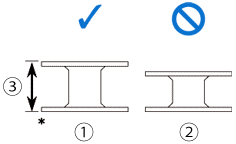 |
* Made of plastic
(1) This model (2) Other models (3) 11.5 mm (approx. 7/16 inch) |
- When winding the bobbin for sewing utility stitches, use thread appropriate for the fabric that you wish to sew. Normally, the thread will be the same as what is used for the upper threading.
- When winding bobbin for embroidery, be sure to use the recommended 60 weight embroidery bobbin thread for this machine.
-
Place the bobbin on the bobbin winder shaft so that the notch in the bobbin aligns with the spring on the shaft, and then slide the bobbin winder shaft to the right until it snaps into place.
The “Start/Stop” button lights up in orange.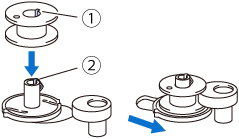
(1) Notch
(2) Bobbin winder shaft spring
-
Remove the spool cap and place the spool of thread for the bobbin onto the spool pin.
Slide the spool onto the spool pin so that the thread unwinds to the front from the bottom. Otherwise the thread may become tangled around the spool pin.
(1) The thread unwinds to the front
from the bottom.
-
Slide the spool cap onto the spool pin.
Slide the spool cap as far as possible to the right, as shown, with the rounded side on the left.
- If the spool or the spool cap is not installed correctly, the thread may become tangled around the spool pin, causing the needle to break.
-
Three spool cap sizes are available, allowing you to choose a spool cap that best fits the size of spool being used. If the spool cap is too small for the spool being used, the thread may catch on the slit in the spool or the machine may be damaged. When using mini king thread spool, use the thread spool insert (mini king thread spool).

-
When using the spool as shown below, use the small spool cap, and leave a small space between the cap and the spool.
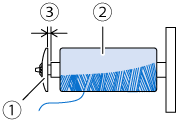
(1) Spool cap (small)
(2) Spool (cross-wound thread)
(3) Space
-
When using thread that winds off quickly, such as transparent nylon thread or metallic thread, place the spool net over the spool before placing the spool of thread onto the spool pin. If the spool net is too long, fold it to fit the size of the spool.
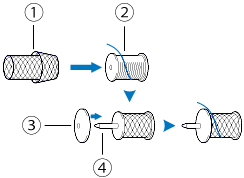
(1) Spool net (2) Spool
(3) Spool cap
(4) Spool pin
-
If a spool of thread whose core is 12 mm (1/2 inch) in diameter and 75 mm (3 inches) high is inserted onto the spool pin, use the thread spool insert (mini king thread spool).
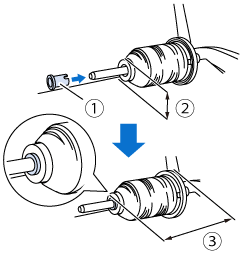
(1) Thread spool insert
(mini king thread spool)
(2) 12 mm (1/2 inch)
(3) 75 mm (3 inches)
-
Pass the thread under the thread guide, then under the thread guide cover and to the front.
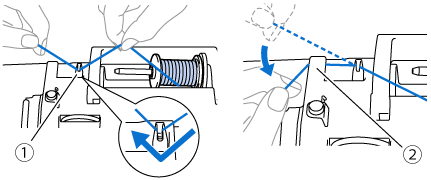
(1) Thread guide
(2) Thread guide cover
-
Pass the thread under the hook on the bobbin winding thread guide, and then wind it counterclockwise under the pretension disk.

(1) Bobbin winding thread guide
(2) Pretension disk
(3) Pull it in as far as possibleMake sure that the thread is passed under the pretension disk.
-
Wind the thread clockwise around the bobbin 5 or 6 times, pass the thread through the guide slit in the bobbin winder seat, and then pull the thread to cut it.
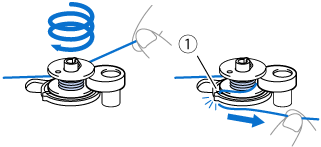
(1) Guide slit in bobbin winder seat
(with built-in cutter)Be sure to wind the thread clockwise around the bobbin, otherwise the thread will become wrapped around the bobbin winder shaft.
Be sure to cut the thread as described. If the bobbin is wound without cutting the thread using the cutter built into the guide slit in the bobbin winder seat, the thread may become tangled in the bobbin or the needle may bend or break when the bobbin thread starts to run out.
-
Slide the sewing speed controller to adjust the bobbin winding speed. Slide the controller to the right to increase the speed; slide it to the left to reduce the speed.
 We recommend winding stretch thread, such as transparent nylon thread, at a low speed since the thread may stretch.
We recommend winding stretch thread, such as transparent nylon thread, at a low speed since the thread may stretch.
-
Turn on the machine.
-
Press the “Start/Stop” button once to start winding the bobbin. When the foot controller is plugged in, press down on the foot controller.

When winding transparent nylon thread on the bobbin, stop bobbin winding when the bobbin is 1/2 to 2/3 full. If the bobbin was fully wound with transparent nylon thread, it may not be wound neatly, or sewing performance may suffer. In addition, extreme pressure may be applied to the bobbin, it may not be possible to remove the bobbin from the bobbin winder shaft, or the bobbin may break.

-
When the bobbin winding becomes slow, press the “Start/Stop” button once to stop the machine. When the foot controller is plugged in, remove your foot from the foot controller.
When the bobbin winding becomes slow, stop the machine, otherwise the machine may be damaged.
-
Cut the thread, slide the bobbin winder shaft to the left until it snaps into place, and then remove the bobbin.
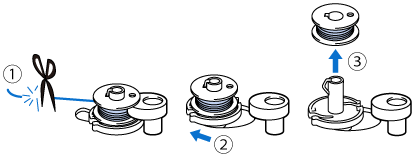
If the bobbin winder shaft is set to the right side, the needle will not move. (Sewing is impossible.)
-
Slide the sewing speed controller to desired sewing speed position.
-
Remove the spool for the bobbin thread from the spool pin.
When the machine is started or the handwheel is turned after winding the bobbin, the machine will make a clicking sound; this is not a malfunction.